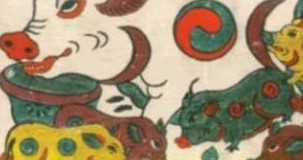Đàm Trung Pháp
“ODE TO A PAINTING OF CHICKENS AND PIGS”
A POEM BY VŨ HOÀNG CHƯƠNG

According to Mencius, a defining quality of a great man is his fearless adhesion to his principles in the face of threats and the use of force. This crown-jewel element of moral character is expressed in Sino-Vietnamese as “uy vũ bất năng khuất 威武不能屈.” Vũ Hoàng Chương (1915-1976) – South Vietnam’s poet laureate – proved this quality by penning the poem “Vịnh tranh gà lợn” (Ode to a painting of chickens and pigs) to satirize the so-called “victors” of the Vietnam War, while ushering in the Lunar New Year of the Dragon (Bính Thìn) in early 1976. As anticipated, Vũ Hoàng Chương’s public defiance of the new regime landed him in jail, from which he was released when he was near death. Five days later, on September 6, 1976, the undaunted poet passed away at home. My translation of the poem into English and its original in Vietnamese appear below with my comments:
ODE TO A PAINTING OF CHICKENS AND PIGS – VỊNH TRANH GÀ LỢN
1. Dawn it’s clearly not, yet dusk too soon – Sáng chưa sáng hẳn tối không đành
2. Boisterous chickens and pigs stir up the painting – Gà lợn om xòm rối bức tranh
3. Walls have ears, poetry runs risks – Rằng vách có tai thơ có họa
4. How are we to tell whose heart is red and whose eyes blue – Biết lòng ai đỏ mắt ai xanh
5. Brotherly chicken eyes have oftentimes been blinded – Mắt gà huynh đệ bao lần quáng
6. Pig guts have stayed true in matter of death and life – Lòng lợn âm dương một tấc thành
7. It’s about time to stop your crows and your oinks – Cục tác nữa chi ngừng ủn ỉn
8. To listen to a new song the dragon sonorously declaim – Nghe rồng ngâm váng khúc tân thanh
Vũ Hoàng Chương’s poetic genius graces the poem with profound allegories, apt metaphors, delightful collocations, amazing expressions capable of double interpretations, and masterful syntactical and semantic parallelism in the two middle couplets (i.e., verses 3-4 and 5-6). Unfortunately, these poetic felicities have been lost in translation! Wishing to somehow compensate for this huge injustice, I humbly provide the following explications for the original poem. Needless to say, I will be very grateful for constructive comments from readers.
The poem’s title suggests that it is about the celebration of the arrival of a lunar new year (tết) in Vietnam. On this occasion, paintings that are bright, showy and simple in content and form (tranh dân gian) are on display to entertain, educate, or express New Year’s wishes to visitors. Paintings expressing good wishes often contain chickens and pigs in them, as well as generals (tướng quân) and doctors of literature (tiến sĩ nho học). Those focused on entertaining feature such comical themes as the rat that finished first in an imperial examination to select doctors of literature (chuột đỗ trạng nguyên). And among paintings praising the value of education, a popular one shows a toad going to school (cóc đi học).
Verses 1 and 2 allude to a most daunting time of uncertainty in the nation’s history, with rampant lawlessness and utter political chaos, after South Vietnam had to surrender to the invading North Vietnamese military force in the spring of 1975. Chickens and pigs are introduced as the main characters of the painting. They also serve as metaphors for the new victors of the war, who were indeed boisterous and caused upheavals in the South Vietnamese society.
Verses 3 and 4 make up a splendid syntactical and semantic parallelism graced by a number of popular proverbs depicting the insecure feeling of being surrounded by spies. The phrase “thơ có họa” in verse 3 can be understood as either “poetry with paintings in it” or “(writing) poetry runs risks.” The implied meaning of verse 4 is that it is impossible to distinguish friends – identified by the Sino-Vietnamese collocation “đan tâm 丹心meaning “red heart” or “unshakable loyalty” – from foes.
Verses 5 and 6 make up another superb syntactical and semantic parallelism adorned by a number of delightful collocations joining such words as “mắt” (eye) and “gà” (chicken) to invoke the vision disorder known as nyctalopia (bệnh quáng gà) and “lòng” (gut) and “lợn” (pig) to refer to a Vietnamese delicacy often served on festive occasions. While verse 5 is an admission that people in the South have often been duped by communist propagandas, verse 6 extols the unfailing truthfulness in the hearts of these same people.
Verses 7 and 8, the powerful final couplet, clinch the poem with a strong message which scolds the gloating “victors” and tells them to stop crowing and oinking in order to listen to a sonorous declamation of a new song by the dragon. I surmise the awe-inspiring animal here is the metaphor for the poet himself – in the very beginning of a lunar year honoring the dragon (tết năm con rồng, bính thìn 1976) – and his “new song” (khúc tân thanh) reminds readers of “Đoạn trường tân thanh,” the original title that Nguyễn Du had given to his Truyện Kiều, Vietnam’s poetic magnum opus. And that original title can be translated as “New song of the severed gut” – obviously not a good omen for the South Vietnamese people in the years to come.
[ĐTP 2010]

